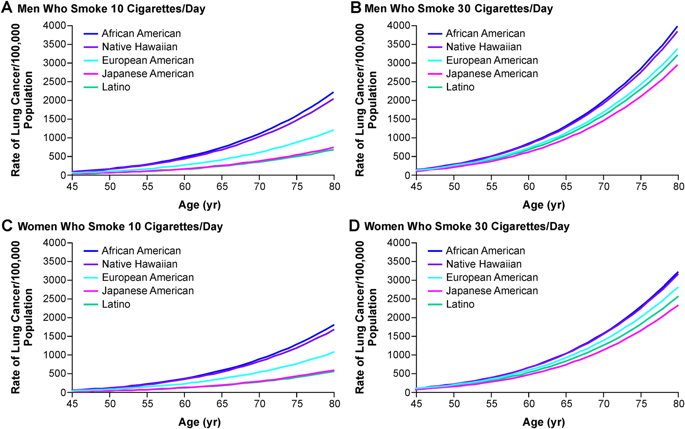npj Precision Oncology ( IF 7.9 ) Pub Date : 2018-08-22 , DOI: 10.1038/s41698-018-0057-y Sharon E Murphy 1 , Sungshim Lani Park 2 , Silvia Balbo 1 , Christopher A Haiman 2 , Dorothy K Hatsukami 1 , Yesha Patel 2 , Lisa A Peterson 1 , Irina Stepanov 1 , Daniel O Stram 2 , Natalia Tretyakova 1 , Stephen S Hecht 1 , Loïc Le Marchand 3

|
The Multiethnic Cohort Study has demonstrated that African Americans and Native Hawaiians have a higher risk for lung cancer due to cigarette smoking than Whites while Latinos and Japanese Americans have a lower risk. These findings are consistent with other epidemiologic studies in the literature. In this review, we summarize tobacco carcinogen and toxicant biomarker studies and genetic analyses which partially explain these differences. As determined by measurement of total nicotine equivalents in urine, which account for about 85% of the nicotine dose, African Americans take up greater amounts of nicotine than Whites per cigarette while Japanese Americans take up less. There are corresponding differences in the uptake of tobacco smoke carcinogens such as tobacco-specific nitrosamines, polycyclic aromatic hydrocarbons, 1,3-butadiene, and other toxic volatiles. The lower nicotine uptake of Japanese Americans is clearly linked to the preponderance of low activity forms of the primary nicotine metabolizing enzyme CYP2A6 in this ethnic group, leading to more unchanged nicotine in the body and thus lower smoking intensity. But the relatively high risk of Native Hawaiians and the low risk of Latino smokers for lung cancer are not explained by these factors. The possible role of epigenetics in modifying lung cancer risk among smokers is also discussed here. The results of these published studies may lead to a better understanding of susceptibility factors for lung cancer in cigarette smokers thus potentially identifying biomarkers that can detect those individuals at highest risk so that preventive approaches can be initiated at an early stage of the lung cancer development process.
中文翻译:

烟草生物标志物和遗传/表观遗传分析研究吸烟者肺癌风险的种族/种族差异
多种族队列研究表明,非裔美国人和夏威夷原住民因吸烟而患肺癌的风险高于白人,而拉丁裔和日裔美国人的风险较低。这些发现与文献中的其他流行病学研究一致。在这篇综述中,我们总结了烟草致癌物和有毒物生物标志物研究和遗传分析,部分解释了这些差异。通过测量尿液中的总尼古丁当量(约占尼古丁剂量的 85%)来确定,非裔美国人每支香烟吸收的尼古丁量比白人多,而日裔美国人吸收的尼古丁量较少。对烟草烟雾致癌物如烟草特有的亚硝胺、多环芳烃、1,3-丁二烯以及其他有毒挥发物的吸收也存在相应的差异。日裔美国人较低的尼古丁摄入量显然与该族群中初级尼古丁代谢酶 CYP2A6 的低活性形式占主导地位有关,导致体内未变化的尼古丁较多,从而降低吸烟强度。但夏威夷原住民患肺癌的风险相对较高,而拉丁裔吸烟者患肺癌的风险较低,这并不能用这些因素来解释。本文还讨论了表观遗传学在改变吸烟者肺癌风险方面的可能作用。这些已发表的研究结果可能有助于更好地了解吸烟者肺癌的易感因素,从而有可能识别出能够检测出风险最高的个体的生物标志物,从而可以在肺癌发展过程的早期阶段启动预防措施。


























 京公网安备 11010802027423号
京公网安备 11010802027423号